Key Lime Pie

introduction
Let’s say that as fillings go, lemon curd is dense, lemon meringue is slick, and Key lime is cloying. An incomparable filling, then, might be suave and creamy with a wily tart streak and a trill of pure lime. Its meringue would be glossy and lush within, and caramel-tipped toasted marshmallow without. Its crust would be short and sturdy with a proper collar and a crazy-big graham taste. It would shiver slightly when sliced, but remain beautifully upright on the plate.
It would be a pie to make you forget pies of the same name that came before it. It would be this pie.
Baking Notes
Before beginning work on this recipe, we had never actually met a Key lime. Turns out they’re very, very small. Not only that, but squeezing Key limes is like drawing blood from a stone. Key lime juice is more tart than Persian (conventional) lime juice, which is pleasantly bracing in the context of a pie. Key limes have a captivating floral, tropical scent. When we smell them we think of gin. When we smell Persian limes we think of gin, too. Are Key limes essential for a making great Key lime pie? Thankfully, no. Use them if they’re nearby, but make the pie irrespective.
Now, we have nothing against sweetened condensed milk—in coffee. But, in our opinion, it brings out the worst in a pie. Combined with yolks and citrus, and put over heat, sweetened condensed milk becomes suspiciously cheesy, stepping on the clean citrus authority of the pie. We choose to drop a big spoonful of crème fraîche into the filling after it comes off the heat, creating a refreshing, bright dairy finish.
On to the meringue! So much hysteria and hand-wringing attend meringues, and their tendency to weep and bead. So much preclusive corn syrup and cornstarch find their ways into a formula with only two real ingredients to its name: sugar and egg whites. Caveats about hot fillings, about making the meringue touch the crust’s edge to prevent shrinkage sound almost fetishistic. Most recipes tell you to bake the pie for 20 minutes to cook the meringue through. Which is fine, except your meringue comes out the shade of a wet brown beach, not tawny and snow capped like in the pictures.
An Italian meringue, which uses hot sugar syrup to poach the egg white foam, addresses all these issues. Once completed, the meringue is stable and requires no additional baking. (The Swiss, the French, and the Italians lay claim to their own meringues, and each meringue applies a different technique to the same two ingredients.) It is softer, silkier, and less potentially Styrofoam-y than conventional pie meringues. If the whites are fresh, the equipment clean, the ingredient proportions correct, and the sugar temperature observed, the resultant meringue will be lush and creamy, ready to hand-sculpt or pipe onto the pie, and will not weep its sorrows into the filling. The best part: you can skip the oven altogether and burnish your meringue with a torch.
Egg whites hate fat, soap, and rain—in that order.
The larger solution to the success of this pie (both layers) is the quality of the eggs that go into it. And by that we mean, in frank terms, that a “sell by” date on a carton of supermarket eggs is a meaningless metric. Get to a farmers market if there is one near you or find a local egg producer at your grocery store. Good, fresh eggs will have high-standing—not runny—whites, and rich marigold-yellow yolks.
It may sound fussy to weigh eggs. But the 50 grams that should constitute a “large” egg (about two-thirds white and one-third yolk) might weigh more or less overall, or be proportionately askew: some really small yolks slip through our fingers! When it comes to preparations that rely on eggs for their thickening, weights and proportions are important!
This filling, which is particularly silky and fine, is not overburdened with cornstarch. But the key ingredients responsible for its fine texture must be cooked properly and cooked enough. Cornstarch requires about 20 seconds of simmering to gel. And the yolks need a watchful direct simmer also. An undercooked filling will not set up properly.
equipment mise en place
To make this recipe, you will need a digital kitchen scale, a rasp-style grater, two small bowls, a nonreactive fine-mesh strainer, a 1- or 2-cup liquid measuring cup, a stand mixer with a very clean bowl and a whisk attachment, a heavy-bottomed nonreactive medium saucepan, a whisk, a ladle, a rubber spatula, a small heavy-bottomed saucepan, a digital instant-read thermometer, an icing spatula or pastry bag fitted with a large plain or star tip, and a kitchen torch to brown the meringue (alternatively, this can be done under the broiler).
-
for the filling:
-
12ounces (4 to 6) Persian limes or 1 pound of Key limes (about 16), washed
-
4ounces crème fraîche
-
5large eggs
-
6 or 7ounces sugar
-
1.5ounces cornstarch
-
¼teaspoon fine sea salt
-
12.5ounces spring or filtered water
-
-
-
1recipe Graham Pâte Sucrée
-
-
for the meringue:
-
4 to 4.25ounces egg whites (from 4 large eggs used to make the filling)
-
½teaspoon cream of tartar
-
Sugar (4 to 4.25 ounces, depending on the weight of the egg whites)
-
2ounces spring or filtered water
-
½teaspoon vanilla extract
-
-
Make the filling: A lime family, depicted here (fig. 1.1) shows the size differential between a conventionally grown Persian lime (the father), an organically grown Persian lime (the mother) and a Key lime (baby). Using a rasp-style grater, grate 1 tablespoon of zest from the limes (fig. 1.2), removing only the outermost skin, and none of the white pith (you will not need to zest all the limes to obtain 1 tablespoon of zest). Turn the zest into a small bowl, stir in 1 ounce of the crème fraîche, cover, and set aside. Set a nonreactive fine-mesh strainer over a 1- or 2-cup liquid measuring cup. Squeeze the juice from the limes into the strainer until you have ½ cup of strained juice.
-
Set a sparkling clean stand mixer bowl set on a digital kitchen scale and turn on the scale. Separate the eggs, turning the yolks into a small bowl and 4 of the whites into the mixer bowl. The whites should weigh between 4 and 4.25 ounces; note their weight, cover the whites, and set them aside. Set a fine-mesh strainer over a medium bowl and set the bowl on the scale. Whisk the yolks and scrape them into the strainer; push the last few drops of yolk through with a small spoon. The strained yolks should weigh between 3 and 3½ ounces; this is important. If they do not, adjust accordingly by spooning some off if there is too much or adding additional yolk if there isn’t enough. Cover the yolks and set them aside.
-
In a heavy-bottomed nonreactive medium saucepan, place 6 ounces of sugar if using Persian limes or 7 ounces of sugar if using Key limes. Add the cornstarch and salt and whisk well. Add the water and whisk again. Cook the mixture over medium-high heat, whisking frequently. As it begins to simmer and thicken (fig. 3.1)—after about 5 minutes—lower the heat slightly and allow the mixture to reach a gentle boil while continuing to whisk; it will form a thick, translucent gel. Remove the pan from the heat and ladle about 1½ cups of the hot gel a little at a time into the yolks to warm them (fig. 3.2). Whisk well to combine, and then scrape the tempered yolks back into the saucepan and stir until no yellow streaks remain. Set the saucepan over low heat and bring the mixture to a gentle simmer, whisking constantly, 1 to 2 minutes. Off heat, whisk in the lime juice a little at a time (fig. 3.3). Add the remaining 3 ounces of crème fraîche and whisk well. Let the filling cool for 5 minutes, and then whisk in the zest mixture. Scrape the filling into the baked pie shell and smooth the top (fig. 3.4). Cover the filling flush with plastic wrap and refrigerate the pie until completely cool and set, about 3 hours.
-
Make the meringue and finish the pie: After the pie has chilled and just before you are ready to serve, sift the cream of tartar into the egg whites in the mixer bowl. Attach the bowl to the stand mixer fitted with a whisk attachment. Into a small heavy-bottomed saucepan set on a digital kitchen scale, weigh out the sugar to equal the weight of the egg whites. Pour the water onto the sugar and set the pan over medium heat. Cook the mixture, occasionally swirling the pan to dissolve the sugar. When syrup reaches 225 degrees on a digital instant-read thermometer (fig. 4.1)—which should take about 5 minutes—lower the heat slightly and begin whipping the egg whites on medium speed. When the whites have fine bubbles throughout, increase the speed to medium-high and continue beating until they begin to look creamy but do not yet form peaks, about 3 minutes (fig. 4.2). By this time the syrup should register 240 degrees. With the mixer running, pour the hot syrup in a steady stream into the egg whites, trying to avoid contact with the moving whisk. Once all the syrup has been added, continue beating until the meringue is lukewarm, glossy, and supple (fig. 4.3), no more than 5 minutes. Stir the vanilla.
-
If you will be broiling the pie to brown the meringue, adjust an oven rack to lower-middle position and preheat the broiler. Remove the pie from refrigerator and peel off the plastic. Spread the meringue over the filling with an icing spatula or pipe it on with pastry bag fitted a large plain or star tip. We like to swirl patterns and create peaks with our fingers. Use a kitchen torch to brown parts of the meringue (fig. 5.1) or slide the pie under the broiler for a few seconds to brown the meringue, rotating it so that it colors evenly.
-
-
1.1
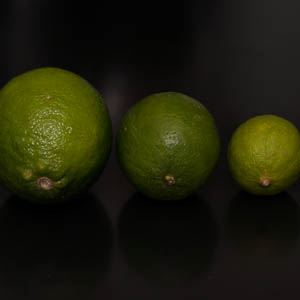
-
1.2
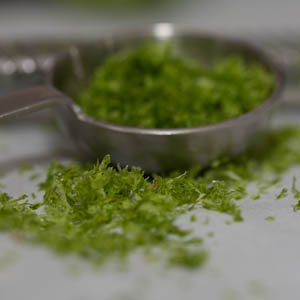
-
-
-
3.1
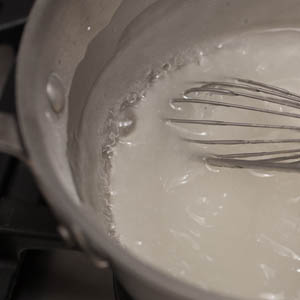
-
3.2
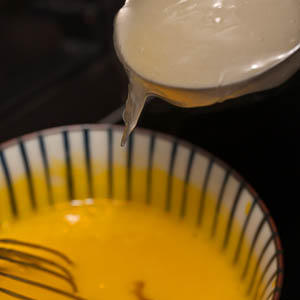
-
3.3
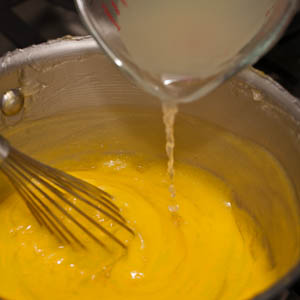
-
3.4
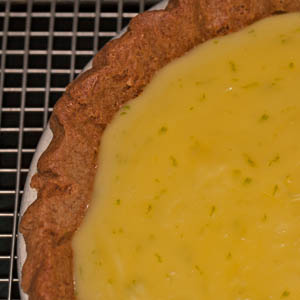
-
-
-
4.1
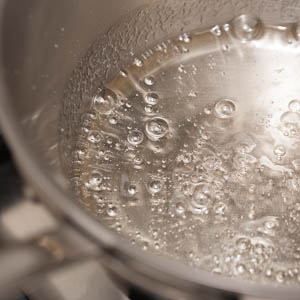
-
4.2
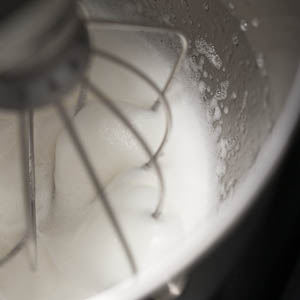
-
4.3
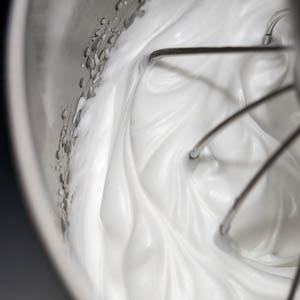
-
-
-
5.1
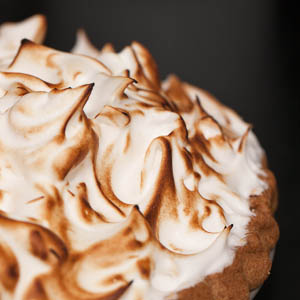
-